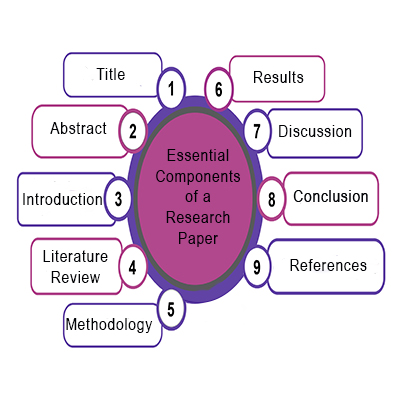Essential Components of a Research Paper

Essential Components of a Research Paper
Writing a research paper is a fundamental skill for academic and professional success. A well-structured research paper ensures clarity, credibility, and precision. Below, we break down the essential sections every research paper should include, providing insights into their significance and how they contribute to the overall impact of your work.
- Title: The First Impression
The title is the gateway to your research paper. It must be concise yet descriptive, providing readers with a clear idea of the topic and scope of your study. A strong title attracts attention and sets the tone for what follows.
- Abstract: A Snapshot of the Study
The abstract serves as a summary of the entire paper. In just a few sentences, it highlights the research question, methods, key findings, and implications. Writing an impactful abstract is crucial as it helps readers quickly decide whether to read the full paper.
- Introduction: Setting the Stage
The introduction provides context and establishes the purpose of your research. It should present the research question, explain its relevance, and outline the paper's objectives. A strong introduction captures the reader’s interest and clearly defines the paper’s direction.
- Literature Review: Building the Foundation
A literature review explores existing research related to your topic. This section demonstrates your understanding of the subject, identifies gaps in knowledge, and justifies your study's contribution. A thorough review adds depth and credibility to your work.
- Methodology: Detailing the Approach
The methodology explains how the research was conducted. It includes details about data collection, tools, techniques, and analysis methods. This section ensures the research is reproducible and allows readers to evaluate its validity.
- Results: Presenting the Findings
The results section showcases the outcomes of your study. It should present data in a clear and logical manner, often using tables, charts, or graphs for better comprehension. Focus on the facts without interpretation.
- Discussion: Interpreting the Results
The discussion interprets the results, connecting them to the research question and existing literature. This section highlights the significance of your findings, discusses limitations, and provides suggestions for future research.
- Conclusion: Wrapping It Up
The conclusion summarizes the key findings and emphasizes their implications. It brings closure to the paper while reinforcing the importance of the study. A strong conclusion leaves a lasting impression on the reader.
- References: Crediting the Sources
The references section lists all the sources cited in the paper. Proper citation not only gives credit to original authors but also enhances the credibility of your work by showing the foundation of your research.
Final Thoughts
Understanding and mastering these components is essential for producing high-quality research papers. Each section plays a distinct role in presenting your work in a logical, professional, and impactful manner. By following these guidelines, you can ensure your research paper effectively communicates your insights and findings to your audience.




